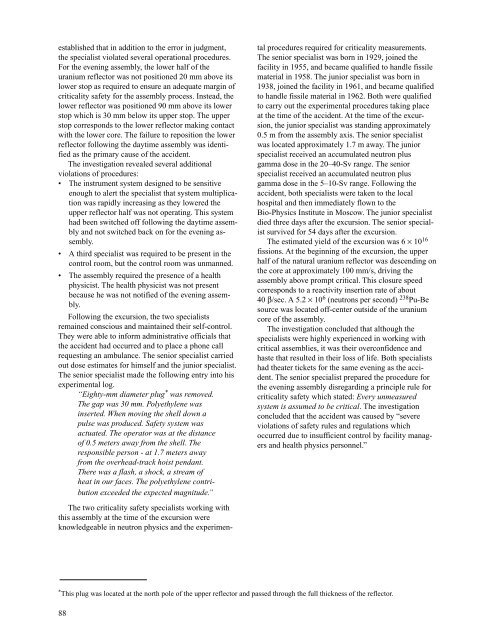A Review of Criticality Accidents A Review of Criticality Accidents
A Review of Criticality Accidents A Review of Criticality Accidents
A Review of Criticality Accidents A Review of Criticality Accidents
Create successful ePaper yourself
Turn your PDF publications into a flip-book with our unique Google optimized e-Paper software.
established that in addition to the error in judgment,<br />
the specialist violated several operational procedures.<br />
For the evening assembly, the lower half <strong>of</strong> the<br />
uranium reflector was not positioned 20 mm above its<br />
lower stop as required to ensure an adequate margin <strong>of</strong><br />
criticality safety for the assembly process. Instead, the<br />
lower reflector was positioned 90 mm above its lower<br />
stop which is 30 mm below its upper stop. The upper<br />
stop corresponds to the lower reflector making contact<br />
with the lower core. The failure to reposition the lower<br />
reflector following the daytime assembly was identified<br />
as the primary cause <strong>of</strong> the accident.<br />
The investigation revealed several additional<br />
violations <strong>of</strong> procedures:<br />
• The instrument system designed to be sensitive<br />
enough to alert the specialist that system multiplication<br />
was rapidly increasing as they lowered the<br />
upper reflector half was not operating. This system<br />
had been switched <strong>of</strong>f following the daytime assembly<br />
and not switched back on for the evening assembly.<br />
• A third specialist was required to be present in the<br />
control room, but the control room was unmanned.<br />
• The assembly required the presence <strong>of</strong> a health<br />
physicist. The health physicist was not present<br />
because he was not notified <strong>of</strong> the evening assembly.<br />
Following the excursion, the two specialists<br />
remained conscious and maintained their self-control.<br />
They were able to inform administrative <strong>of</strong>ficials that<br />
the accident had occurred and to place a phone call<br />
requesting an ambulance. The senior specialist carried<br />
out dose estimates for himself and the junior specialist.<br />
The senior specialist made the following entry into his<br />
experimental log.<br />
“Eighty-mm diameter plug * was removed.<br />
The gap was 30 mm. Polyethylene was<br />
inserted. When moving the shell down a<br />
pulse was produced. Safety system was<br />
actuated. The operator was at the distance<br />
<strong>of</strong> 0.5 meters away from the shell. The<br />
responsible person - at 1.7 meters away<br />
from the overhead-track hoist pendant.<br />
There was a flash, a shock, a stream <strong>of</strong><br />
heat in our faces. The polyethylene contribution<br />
exceeded the expected magnitude.”<br />
The two criticality safety specialists working with<br />
this assembly at the time <strong>of</strong> the excursion were<br />
knowledgeable in neutron physics and the experimen-<br />
88<br />
tal procedures required for criticality measurements.<br />
The senior specialist was born in 1929, joined the<br />
facility in 1955, and became qualified to handle fissile<br />
material in 1958. The junior specialist was born in<br />
1938, joined the facility in 1961, and became qualified<br />
to handle fissile material in 1962. Both were qualified<br />
to carry out the experimental procedures taking place<br />
at the time <strong>of</strong> the accident. At the time <strong>of</strong> the excursion,<br />
the junior specialist was standing approximately<br />
0.5 m from the assembly axis. The senior specialist<br />
was located approximately 1.7 m away. The junior<br />
specialist received an accumulated neutron plus<br />
gamma dose in the 20–40-Sv range. The senior<br />
specialist received an accumulated neutron plus<br />
gamma dose in the 5–10-Sv range. Following the<br />
accident, both specialists were taken to the local<br />
hospital and then immediately flown to the<br />
Bio-Physics Institute in Moscow. The junior specialist<br />
died three days after the excursion. The senior specialist<br />
survived for 54 days after the excursion.<br />
The estimated yield <strong>of</strong> the excursion was 6 × 10 16<br />
fissions. At the beginning <strong>of</strong> the excursion, the upper<br />
half <strong>of</strong> the natural uranium reflector was descending on<br />
the core at approximately 100 mm/s, driving the<br />
assembly above prompt critical. This closure speed<br />
corresponds to a reactivity insertion rate <strong>of</strong> about<br />
40 β/sec. A 5.2 × 10 6 (neutrons per second) 238 Pu-Be<br />
source was located <strong>of</strong>f-center outside <strong>of</strong> the uranium<br />
core <strong>of</strong> the assembly.<br />
The investigation concluded that although the<br />
specialists were highly experienced in working with<br />
critical assemblies, it was their overconfidence and<br />
haste that resulted in their loss <strong>of</strong> life. Both specialists<br />
had theater tickets for the same evening as the accident.<br />
The senior specialist prepared the procedure for<br />
the evening assembly disregarding a principle rule for<br />
criticality safety which stated: Every unmeasured<br />
system is assumed to be critical. The investigation<br />
concluded that the accident was caused by “severe<br />
violations <strong>of</strong> safety rules and regulations which<br />
occurred due to insufficient control by facility managers<br />
and health physics personnel.”<br />
* This plug was located at the north pole <strong>of</strong> the upper reflector and passed through the full thickness <strong>of</strong> the reflector.

















